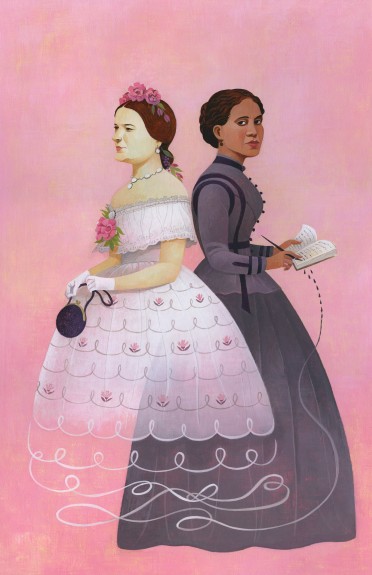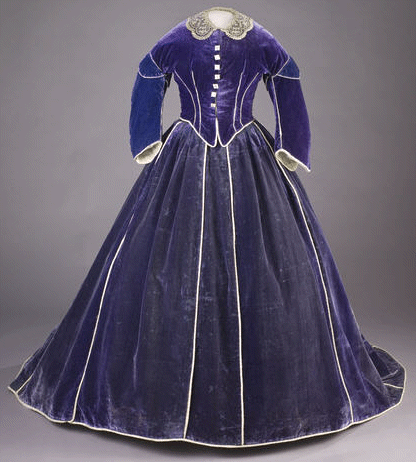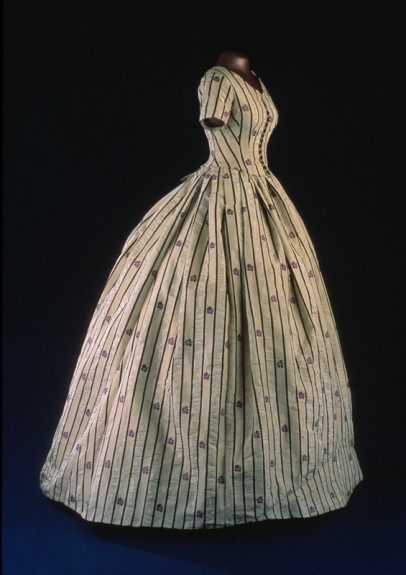The Story of Elizabeth Keckley, Former-Slave-Turned-Mrs. Lincoln’s Dressmaker
A talented seamstress and savvy businesswoman, she catered to Washington’s socialites
![]()

Mary T. & Lizzy K. runs through May 5, 2013, at Arena Stage at the Mead Center for American Theater. Illustration by Jody Hewgill.
Elizabeth Keckley was born into slavery in 1818 in Virginia. Although she encountered one hardship after another, with sheer determination, a network of supporters and valuable dressmaking skills, she eventually bought her freedom from her St. Louis owners for $1,200. She made her way to Washington, D.C. in 1860 to establish her own dressmaking business and met first lady Mary Todd Lincoln.
Just after Abraham Lincoln’s inauguration, in 1861, the FLOTUS hired Keckley (also spelled Keckly) as her personal modiste. Keckley took on the role of dressmaker, personal dresser and confidante, and the two women formed a special bond. Mary T. and Lizzy K., a new play written and directed by Tazewell Thompson, explores their relationship.
Much has been researched, written and analyzed about Keckley’s life as a result of the unusual friendship. In 1868, Keckley published a detailed account of her life in the autobiography Behind the Scenes: Or, Thirty Years a Slave and Four Years in the White House. A thorough study of her dressmaking legacy is still being uncovered, though, explained Elizabeth Way, a former Smithsonian researcher and New York University costume studies graduate student who worked for the Smithsonian last summer researching Keckley.
Prompted by Mary T. and Lizzy K., which runs through May 5, 2013, at the Mead Center for American Theater at Arena Stage in Washington, Threaded spoke with Way about Keckley’s dressmaking handiwork.
Are Elizabeth Keckley designs plentiful today?
Not that many still exist actually. And even with those pieces that do exist, there’s a question as to whether they can be attributed to Keckley. The Smithsonian’s National Museum of American History has a Mary Lincoln gown, a purple velvet dress with two bodices, that the first lady wore during the second presidential inauguration. There’s a buffalo plaid green and white day dress with a cape at the Chicago History Museum. At the Abraham Lincoln Presidential Library and Museum in Illinois, you’ll find a black silk dress with a strawberry motif that you’d wear to a strawberry party, which was a 19th-century Midwestern picnic tradition, but it’s disputed as to whether or not it’s a Keckley. Penn State has a quilt that Keckley made from dress fabrics, and other items are floating around in collections. For example, Howard University has a pincushion with her name on it.

Elizabeth Keckley
You mentioned it’s difficult to attribute clothes to Keckley. Why is that?
At the time, no labels or tags were used. And because fabric was so expensive, dresses were often taken apart and reconstructed as a completely different dress using the same material. She made clothes for many official women in Washington, so one way to determine a Keckley dress is if any of those women kept a journal and noted that kind of detail within it.
I assume she followed fashion conventions of the mid- to late 19th century, but did she have a specific style?
Her style was very pared down and sophisticated, which a lot of people don’t imagine when they think of the Victorian era. Her designs tended to be very streamlined. Not a lot of lace or ribbon. A very clean design.
How did she build such a thriving business as an African-American woman in the mid-1800s?
She was very skilled at building a client network, which was very notable considering she was a black woman and previously enslaved. She consistently made friends with the right people and got them to help her, which was not only a testament to those people, but also to her. She had incredible business savvy.
Would she sew the entire dress?
When she started out, she would do the complete dress, sew it up, add the trim, everything. As she became more successful, she was able to hire seamstresses to do some of the sewing and she trained people to help with the construction. Generally, she would work on the fit of the dresses.

Mary Lincoln’s purple velvet skirt and daytime bodice are believed to have been made by African-American dressmaker Elizabeth Keckley. The first lady wore the gown during the Washington winter social season in 1861–62. National Museum of American History.
Was Mary Lincoln wearing only Keckley while she was the first lady?
Mary Lincoln liked to shop. She would go to New York to shop at the department stores, which were just emerging at that time. You could buy ribbon and trim and anything unfitted, like a cape. It was just the beginning of mass production. But any kind of dress had to be made by a dressmaker because the fit was so specific that it had to be customized. Mary Lincoln was said to order 15, 16 dresses each season, which took about three months to make.
While Mary Lincoln was known, and criticized, for an overly youthful style that embraced bright colors and floral patterns, the dresses made for her by Keckley that have survived are the opposite of that style—Keckley really designed with very clean lines.

Striped and floral Mary Lincoln dress, attributed to Keckley, significantly altered from original design. Smithsonian National Museum of American History.
Where did Mary Lincoln, or other women for that matter, find out about fashion trends?
Fashion at this time copied France line for line. Whatever was happening at the French court was what women in D.C. wanted.
Elizabeth Keckley was an incredible businesswoman and was also known for her beauty.
In her memoir, she recalls that people thought she was beautiful. The Washington Bee, the African American newspaper, treated her like a black socialite within the African-American community. She dressed well—she was not gaudy or showy, but more pared down and refined. She was known for being elegant, upright and appropriate—the Victorian ideal.
How did that Victorian approach play into Keckley’s designs?
The Victorian ideals permeated all levels of American culture and determined what it meant to be an appropriate woman no matter who you were. There were so many social rules about what you had to wear in the daytime and nighttime, and Keckley’s garments all followed those rules, especially for Mary Lincoln, who was in the public eye so frequently.
How long would it take for Keckley to make one dress?
I’m not exactly sure. Maybe two, three weeks. To drape the fabric, cut the fabric, use a sewing machine on some parts and hand-stitch others. Also, remember—she was making multiple dresses at a time, and by the time she was a successful dressmaker in Washington, she also had seamstresses working with her.
What was Keckley most known for amongst women in Washington who wanted a dress from her?
Her fit and her adeptness when it came to draping fabric on the body. She was known to be the dressmaker in D.C. because her garments had extraordinary fit.
What were the dressmaking tools she would have been using at the time?
A rudimentary sewing machine, which is at the Chicago History Museum, pins, needles. She may have measured with inches but because that system was so new, she could have used another marking system for measurement. And she may have used a drafting system that came out in the 1820s for patternmaking.
How much was Keckley earning at the time when she was making dresses for Mary Lincoln?
When Keckley first moved to D.C. and worked as a seamstress for a dressmaker, she made $2.50 a day.
She recalls in her memoir that when she became a dressmaker, she made a dress for Anna Mason Lee who was attending a reception with the Prince of Wales in 1860, which was a very high society event in D.C. Captain Lee gave Keckley $100 to purchase lace and trim for his wife’s dress. So while that doesn’t quite speak to how much she was earning, it does put things in perspective and speak to the level of cost and the timeline of moving from a seamstress to a dressmaker. In fact, when she bought the trim from Harper Mitchell, the trim store, for Lee’s dress, the shop gave her a $25 commission for the purchase. That $25 was already ten times what she was making as a seamstress when she first came to Washington. Working as a dressmaker was the highest-paying opportunity women had during that time period, and Keckley’s dresses were known to be very expensive, the envy of women in Washington.
This interview has been edited and condensed.
/https://tf-cmsv2-smithsonianmag-media.s3.amazonaws.com/accounts/headshot/emily-spivack-240.jpg)
/https://tf-cmsv2-smithsonianmag-media.s3.amazonaws.com/accounts/headshot/emily-spivack-240.jpg)